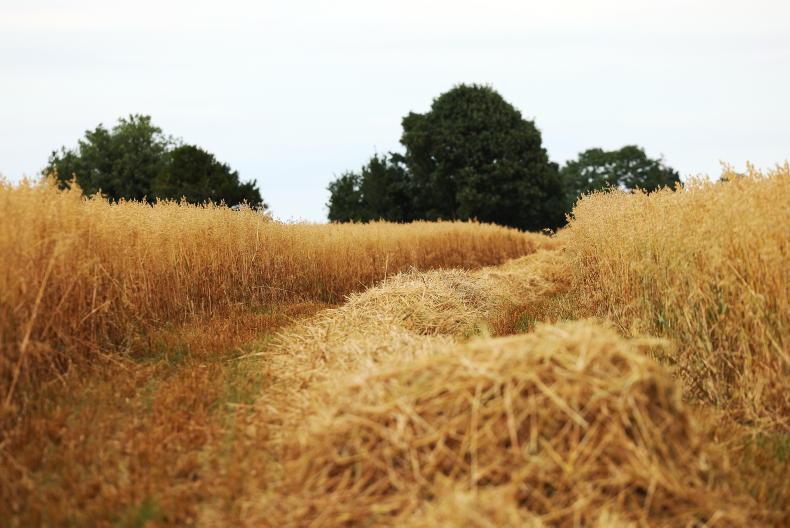The recent Grain Outlook Conference organised by IFA explored the theme of surviving grain market boom-bust cycles. A varied agenda looked at a range of topics from the current fertiliser prices to grain price outlook, the use of Maxammon for grain conservation, new trailer legislation requirements plus advice on terms and conditions relating to both buying and selling.
Opening the conference, IFA chair Jer Bergin said price volatility has not been an issue in recent times because there has been no upside to prices, which have been mainly flat and poor.
However, he called on all farmers to explore the opportunities to take grain directly from the producer to the end user. He also said production systems, scale and infrastructure are different in Ireland and this must be reflected in the way EU policy is framed and implemented.
He said Irish merchants have a role to play in putting forward business models that suit the scene here.
We only produce 2.5m of the 4.5m tonnes of feed sold annually to farmers and this must provide an opportunity to provide full traceability.
There must be shared benefit in such systems, Jer said.
Trailer legislation
While the new trailer regulations present a significant challenge to farmers to upgrade trailer braking and lighting systems, James Maloney of the Irish Farmers Journal suggested that we in Ireland still have more favourable regulations than many of our EU colleagues.
He said that regulations are necessary to protect road users and that the primary decision for most farmers is whether to spec out for under 40km/h or over 40km/h. This decision sets the general cost levels for both tractors and trailers and may force many farmers to decide whether to buy new trailers or to repair or upgrade existing trailers.
These decisions are down to the individual. Modern tractors will comply with their requirements but there are many old trailers which will need modification. But this is possible and trailer manufacturers can advise on braking capacity and efficiency where change may be needed. Trailer manufacturers can also plate older trailers based on their specifications.
James talked about the many new requirements that relate to carrying capacity – axle types, tyre types, plating, lighting, reflectors etc. He also covered all of these in the Irish Farmers Journal in recent weeks. In simple terms, trailers travelling above 40km/h must have air brakes and greater than 60km/h trailers must be fitted with ABS brakes. So travel speed influences the cost of modification.
All tractors on the road must now have a flashing beacon fitted, regardless of the year of manufacture. And 3.5m is the maximum width allowed on the road. Tyres can influence the weight allowed and the speed rating and fitting a ball and spoon hitch can add 1t to the weight allowed on the drawbar. A speed disc must be fitted to all machines.
James concluded by saying that operators need to know the regulations that apply to their specific tractor trailer combinations. Bale trailers are most likely to be checked as there is a maximum length of 18m on any combination and there is also a maximum distance that machines can travel.
Unravelling fertiliser costs
IFA grain secretary Fintan Conway talked about the challenges in the fertiliser market and the fact that EU regulations are forcing EU prices to be higher than is necessary. This story has received a lot of publicity recently. Fintan said the fertiliser industry is a powerful lobby group in Europe and a tariff of 6% applies to all imported fertilisers.
He said the recent fall in energy prices exposed the fertiliser price issue. He also said this problem has been brought to the commission’s attention many times before but that they demand proof of a problem, rather than opinion, before they will act. The IFA has produced a report on the EU pricing arrangements which has since been presented to the commission.
The use of the tariff plus up to €47/t of an anti-dumping levy continues to be imposed on EU fertiliser. Thirty years ago a tonne of grain would buy a tonne of fertiliser. Now it takes over two tonnes of grain to purchase one tonne of fertiliser. And this high cost is decreasing fertiliser use, soil fertility levels are falling and productivity is suffering, resulting in an erosion of incomes.
Grain market pressures
A series of global events have conspired to keep pressure on international grain prices, James Nolan of R&H Hall told the meeting. Farmers have done a good job at producing but the combination of high global harvests, cheap ocean freight costs, bioethanol demand levelling off, more countries exporting grain and currency movements have all led to weaker grain markets.
Barley production has been falling over time, James said. Growers in the Former Soviet Union (FSU) now prefer to grow maize and Argentina may also produce less due the change in the export tax laws there. Freight costs are now so low that ships are used to provide storage in some instances.
While currency is putting pressure on producers in places such as the US (and UK up to recently), it is favourable for producers in some exporting countries such as Ukraine, Russia, Brazil and Argentina. This is encouraging producers there to drive production while other areas are being pressured to cut production.
While surplus is the obvious problem, lack of demand for product is the real problem. James said that mid €160s/t seems like fair value for wheat today but lack of demand means that prices are dropping further in an effort to find a home for grain.
There are a lot of both bullish and bearish factors in the market today but these will not have an effect unless they become real, James said. So supply pressure remains the major driver of market sentiment. James advised growers to steer clear of total dependence on the weak harvest market. There will inevitably be rallies in the market for different reasons and growers must make themselves aware of when these potential selling opportunities occur.
Making more of grain
Maxammon is an enzyme treatment for grain which, when mixed with urea, helps preserve the grain for storage while increasing its protein level. Neil Kidd, from Strathclyde Nutrition in Scotland, said that the product can be added to grain at up to 20% moisture at harvest, along with urea, to give improved animal performance due to the control of rumen acidosis.
Grain can be either whole or rolled at the point of treatment and Neil claimed that it will store safely for up to a year.
Once treated, the pile of grain must be covered with plastic for about two weeks to enable curing to take place. After this the plastic can be removed and the grain piled higher or moved. Treatment results in an increase in pH, plus about 30% increase in protein level.
Nutritionist Brian Reidy said that pH control is critical to make the best use of cereals in ruminant diets. “Once cereals are used safely, they provide better value than substitutes because they increase milk volume and total solids or weight gain and grades and scores in beef animals,” Brian said. He is recommending a 68% cereal ration for cows so it is critical to keep the feed safe. He also said treated oats provide a far more cost-effective option for farmers than soya hulls or pulps.
Conserving grain with Maxammon also provides farmers with the option for farm-to-farm trading.
Cover crop bring back life to soil
Cover crops can help improve soils, both structure/physical condition and fertility. Philip Reck is farm manager for Walter Furlong Grain Ltd in Wexford and he has been an advocate of cover cropping for over a decade. Some years ago Philip realised that continuously cultivated soils were being damaged and that yields were being limited.
Cover crops are more suited to spring cropping as this land can be left bare for up to six months. During this time the soil can be degraded by rain and sunshine leading, over time, to a reduction in soil porosity.
Covering the soil with plants during this period has helped Philip to get his grain yields up, improve nutrient retention and decrease costs over time.
Growing cover crops provides a silent rotation, Philip said, as farmers do not fully realise that is what they are doing. GLAS, ecological focus areas and crop diversification equivalence have increased interest in cover crops and this must be regarded as a good thing. And a well thought-out cover crop mixture can be grazed in situ, providing the opportunity to generate a level of income from the crop and also to improve soil fertility.
Improved soil structure brings many benefits and it is only when you get these back that you realise what had been missing, Philip said. Soils become drier and easier to till, which widens the window of working opportunity. Water will percolate more easily and the presence of old plant roots help prevent compaction and provide channels for water to run through or other roots to grow into. Catch crops help retain valuable nutrients while adding to soil organic matter, earthworm numbers, soil biodiversity and they also to help prevent soil erosion.
Legumes bring the big benefit in catch crops because they leave residual nitrogen. But, as with other species, earliness of planting is important to help maximise the benefit. “Being able to plant catch crops every year will really bring your soil to life,” Philip concluded.
Terms and conditions
The Terms and Conditions associated with the purchase or sale of any product are meant to provide protection to the seller and the buyer against liability issues following the sale of a product. Farmers buy things all the time – from expensive machinery, to basic sprays, to parts for a wheelbarrow. But they also sell things and James Staines of Kennedys Solicitors told the meeting that farmers should consider having terms and conditions printed on the invoices they present for payment at the point of sale.
The producer of a product always has a level of liability, James said, which can be called upon in the event that a product was found to be unsafe. However, resulting economic loss may or may not be covered by liability and this is judged on a case by case basis by the courts.
The Terms and Conditions can be used to cover many issues providing they are made obvious to the purchaser and that they are part of the signed contract of sale.
James gave an example of an updated label on an SDHI fungicide. The Terms and Conditions have been altered to reflect the risk of resistance to the SDHI active in the septoria population.
James feels that this will provide reasonable cover for the manufacturer in the event of resistance expanding, or even control failing, during the course of the growing season. Growers need to be conscious of this situation.












SHARING OPTIONS